
With over 1.1 million discussions and 53 million views across social platforms, “Năm Số 9” (“Year of Cleansing”) has emerged as one of the most viral social slang of 2025. Commonly associated with online drama and emotional turbulence, it’s often used by netizens to explain or react to any chaotic event—especially in entertainment. However, Buzzmetrics’ data reveals a deeper, more nuanced story behind “Năm Số 9.” Beyond its “drama-laden” surface meaning, let’s uncover what lies beneath this social slang phenomenon.
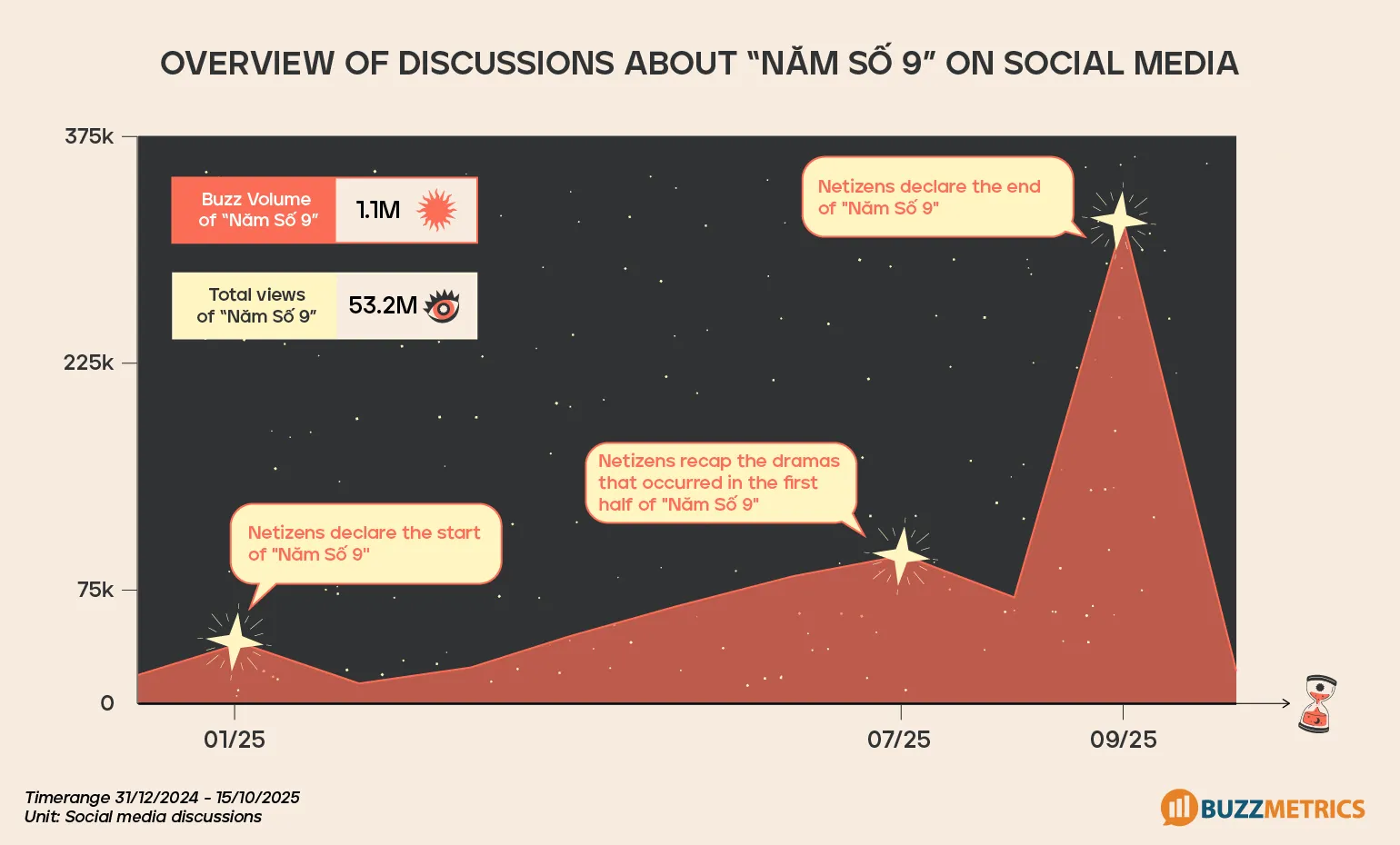
From the discussion timeline, Buzzmetrics identifies three major milestones for “Năm Số 9.” The first milestone was in January 2024, when users started sharing the concept of “Năm Số 9” while preparing for the new year. The second milestone came in July 2025, as people summed up the year’s first-half dramas. The next milestone was in September 2025, when social media was flooded with “reflection,” “cleansing,” and “closure” posts. Many users interpreted September as the symbolic end of “Năm Số 9.” Between these milestones, discussions were kept alive mainly by ongoing online dramas.
It’s clear that “Năm Số 9” is a social slang heavily shaped by online dramas, accounting for 84% of total discussions. Every social media scandal—especially in the entertainment scene—was humorously explained by users through “Năm Số 9” or “Năm Thanh Lọc” (“Year of Cleansing”)

Compared to other social slang, “Năm Số 9” stands out for two main reasons:
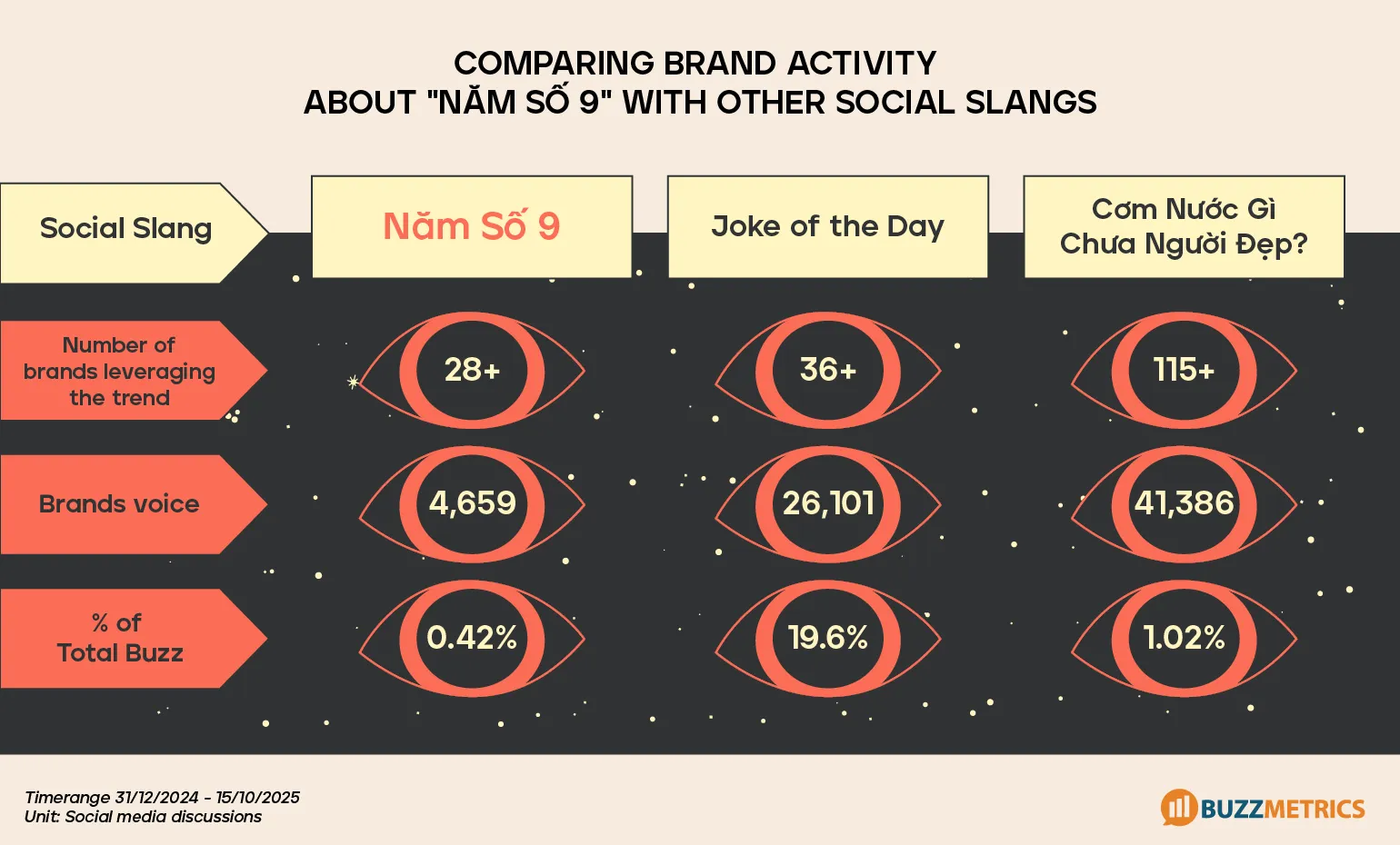
Despite its massive social footprint, brand participation remains minimal—less than 0.5% of total discussions, with only around 30 brands mentioning “Năm Số 9.” These figures are relatively low compared to “Joke of the Day,” another viral social slang from early 2025 that brands leveraged actively due to its flexible usage context. Because “Năm Số 9” is tied to drama, many brands remain cautious in using it. A few brands have referenced “Năm Số 9” in a more positive sense—linking it to mental or physical cleansing—but these efforts have yet to create significant media impact.
By October 2025, discussions around “Năm Số 9” began to cool down, while conversations about “Năm Số 1” (“Year of New Beginnings”) started to surge. If “Năm Số 9” represents a year of cleansing, “Năm Số 1” is seen as a year of planting seeds—symbolizing new beginnings and hope for growth. So, how does “Năm Số 1” differ in its discussion themes, and how can brands make use of it?
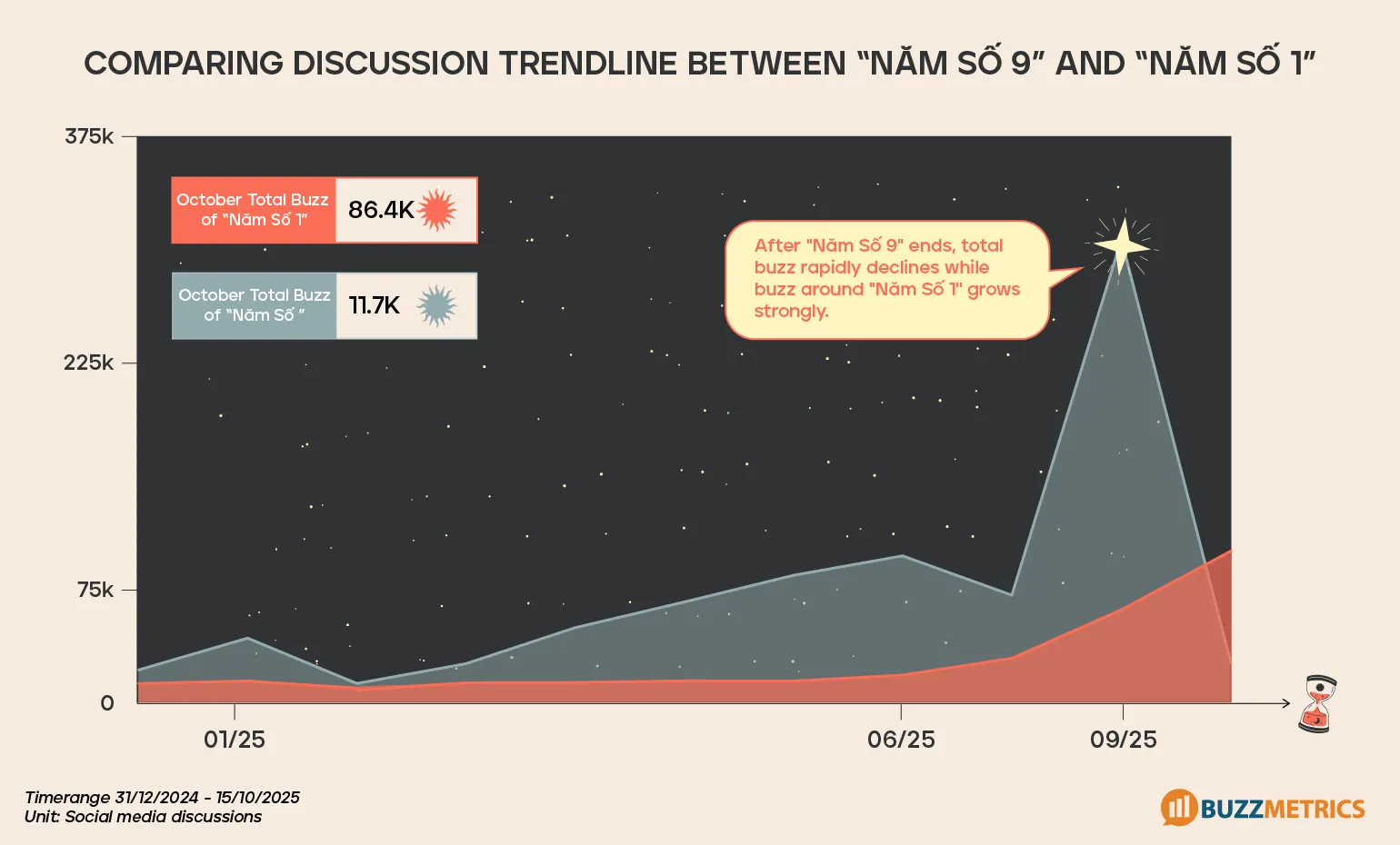
Unlike “Năm Số 9,” discussions about “Năm Số 1” revolve around positive and reflective narratives—messages of optimism, self-growth, and new goals. It’s a social slang dominated by affirmations, gratitude, peace, and emotional healing, making it a strong base for brands to convey inspirational messages.
In other words, if “Năm Số 9” tells a story of “reaping what you sow,” then “Năm Số 1” represents healing and renewal. Through “Năm Số 1,” social users reflect on their past journey, express gratitude, and spread belief in a better new phase ahead.
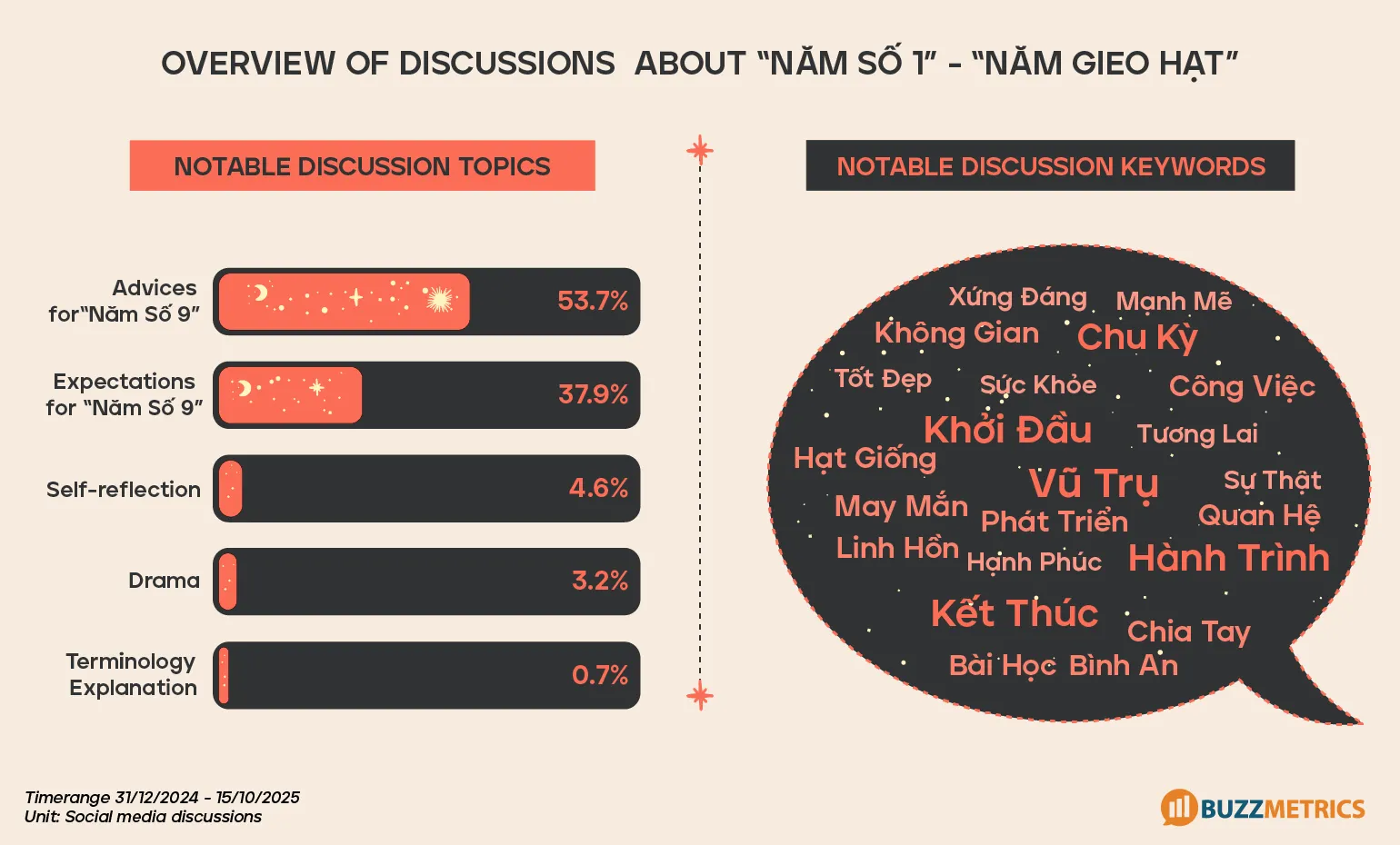
High-frequency keywords reinforce this positive tone—users repeatedly mention “ending,” “cycle,” “beginning,” “growth,” “gratitude,” “strength,” “peace,” and “love.” These words often accompany “Năm Số 1” in blessings and motivational posts.
So, how can brands leverage “Năm Số 1”? There are two main directions for brands to explore:
The duo of “Năm Số 9” and “Năm Số 1” is a fascinating social media phenomenon of 2025. The two Social Slang terms have an interesting correlation regarding:
It is highly likely that “Năm Số 1” will continue to receive user attention for an extended period and reappear in end-of-year review posts. This is a social slang that brands should pay attention to for their year-end communication content.


The tourism industry is constantly evolving and expanding, from service amenities to a variety of travel types that cater to the needs of travelers. According to statistics from Buzzmetrics, at the beginning of 2024, a new wave of travel, known as "healing travel," emerged and gained significant attention among the youth. Instead of merely sightseeing and entertainment, healing travel offers visitors a peaceful space, an opportunity to connect with nature, and a chance to rejuvenate body, mind, and spirit after the pressures of modern life.
The tourism industry is continuously growing and expanding from service amenities to a variety of tourism types that cater to the needs of travelers. According to the Tourism Information Center (Vietnam National Administration of Tourism), in the five-day holiday period from April 30 to May 1, the number of tourists increased by 14.2% compared to the same period in 2023. This demonstrates the attraction and potential of the tourism industry in the coming time.
Additionally, according to statistics from Buzzmetrics, at the beginning of 2024, a new trend in tourism, "healing tourism," has emerged and attracted a lot of interest from young people. Instead of merely sightseeing and entertainment, healing tourism offers visitors a peaceful space, an opportunity to connect with nature, and a chance to rejuvenate body, mind, and spirit after the pressures of modern life.
This report by Buzzmetrics will focus on analyzing this trend and the opportunities for brands, providing readers with a deeper understanding of the exciting aspects behind it, through data research from social networks.

There was a time when traveling often revolved around taking pictures and living virtually. However, the first four months of 2024 have painted a different picture of tourism: Healing ranked second among the travel goals of users. The pressures of work and conflicts in social relationships have led users, especially those under 35, to seek a quiet, less tumultuous place as a way to "review and heal the soul." Exploring new lands is also a way of rediscovering oneself.
Users, primarily the younger ones, also travel to have more profound experiences. They want to expand their knowledge about new regions and are not afraid to engage in activities they have never done before.
While somewhat similar, travel for rest and relaxation usually involves trips where users do not place a heavy emphasis on adventurous exploration. These are often family trips with companions of varying ages.

However, discussions about healing tourism only really emerged around week 11 of 2024 (around mid-March) and peaked in week 15 (around early April). During this period, young people continually shared their experiences with budget healing trips, such as "With a salary of 15 million VND, how to go on a healing trip in 3 months?" or "Earning 5 million VND but still aspiring to go on a healing trip." It seems that even with limited funds, the youth are very keen on healing through travel. This was also the time when the keyword "healing" became popular on social media, attracting attention from the media.
Meanwhile, travel for rest and relaxation peaked during the first five weeks of 2024 (also during the Tet holiday period). However, recently, healing and new experiences have become the main goals for users when traveling.
Based on social media statistics, we can see that the purpose of travel among users is not fixed but changes with the seasons (the period around Tet is different from summer, and summer is different from autumn, etc.). This is an ideal time for healing trips, and healing tourism may continue through the end of the summer.

Typically, when it comes to experiential travel or travel for relaxation, users rarely want to go alone. If seeking experiences, users will choose to go with friends, as friends usually share common interests and are ready to explore new things in new places. If looking to relax, users will opt to go with family, spending time enjoying the company of loved ones after busy days at work.
However, for healing trips, users tend to prefer going alone. Being alone gives them enough space and time to reflect, organize their emotions, and deal with personal issues. It could also be said: If you want to heal, go alone. If you want to experience, go together.

Healing travel destinations that attract interest are usually peaceful places, close to nature, and offer activities that help reduce stress and enhance mental well-being. Below are a few locations for this type of tourism that were most discussed on social media in early 2024.
Ha Long, and especially Co To Island, are particularly favored by users for healing trips. Although Co To does not have many entertainment spots, its pristine nature and clear sea waters are very suitable for "healing." Additionally, Co To is entering its most beautiful season (May), making it an ideal destination in the healing travel plans.
Phu Yen is another ideal destination for healing. Besides its quiet beaches and clear skies, Phu Yen is also sought after for its delicious and affordable food. Discussions about Phu Yen were most vibrant in the late March to early April period, with a series of posts sharing about budget-friendly Phu Yen travel and activities such as watching the sunrise, sunset, and sea views.
In addition to Ha Long and Phu Yen, coastal areas like Phan Thiet, Quy Nhon, Nha Trang, and Phu Quy are also actively discussed by users when it comes to healing. A common feature of these areas is their tranquil settings, which help users to rejuvenate mentally.
(1) It can be seen that healing tourism is an emerging travel trend that is attracting the attention of the online community. This trend is likely to continue at least until the end of the summer.
(2) Each travel goal has different key moments and different companions. Connecting the right goal, the right moment, and the right companions will help optimize the effectiveness of communications for the brand.
(3) Healing travel destinations under discussion may change over time, but a common feature must be a coastal area that is not too bustling, allowing visitors to truly heal.


Social Listening is a form of market research based on social media discussions, helping to analyze brand health, campaigns, special events, and more...
Along with the development of social networks, Social Listening is also growing in application capabilities. If in the past, Social Listening was only about collecting social media data, today data collection is only a part of Social Listening. Measuring buzz volume or sentiment is no longer the only function of Social Listening. In the context of this article, let's look at old questions through a new lens: What is social listening and what role does it play in social media marketing?
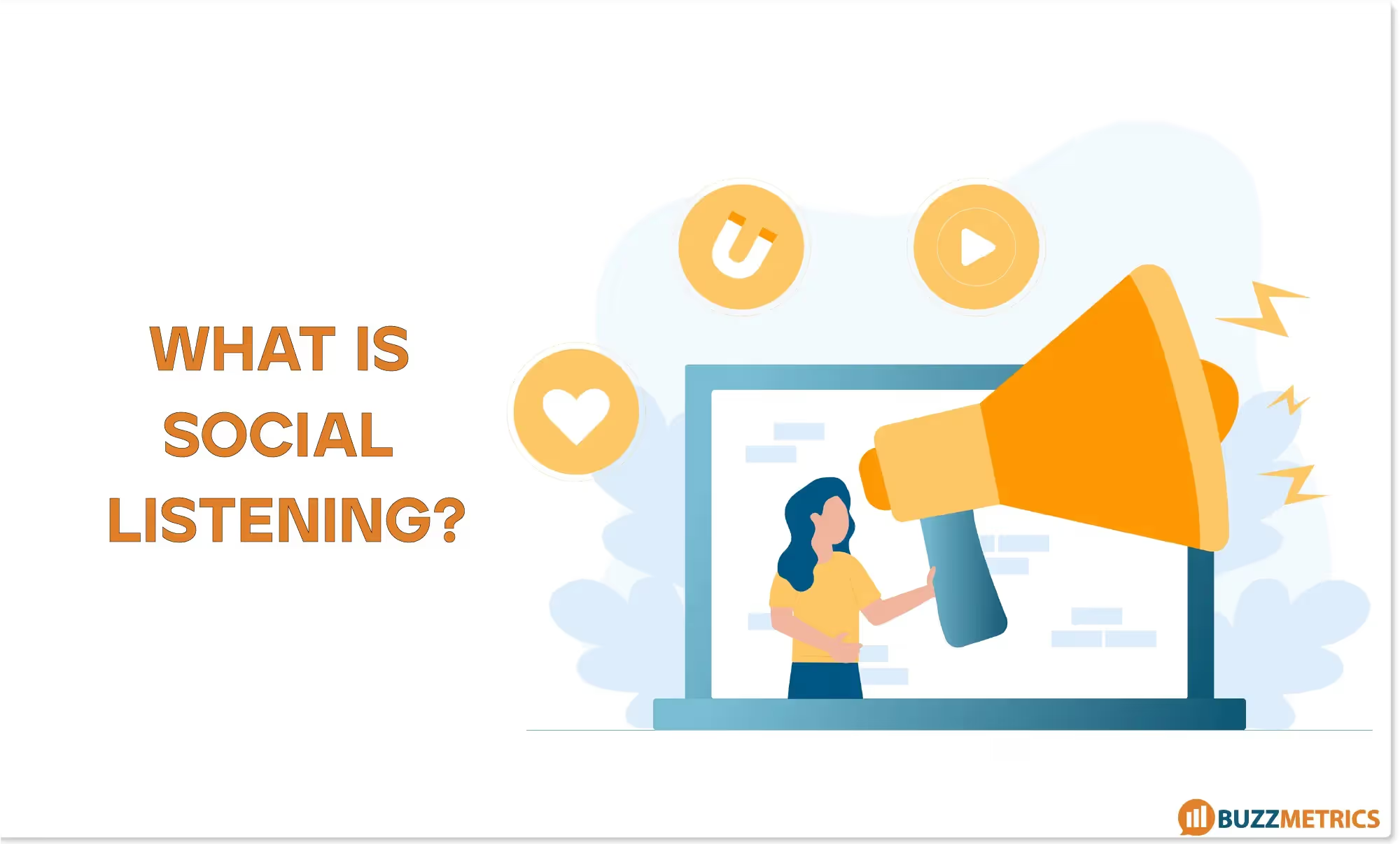
Social Listening is a form of market research that analyzes online user discussions across social media platforms. It involves the collection and analysis of conversations from various online platforms, including social media, forums, blogs, news sites, and review websites. Unlike traditional research methods, Social Listening works primarily with unstructured data, offering businesses real-time feedback from diverse users across different online platforms.
Typically, a Social Listening process follows these steps:
- Step 1: Build an analysis plan
Researchers begin by defining the context and research objectives, then set the key questions to be addressed.
- Step 2: Data collection
Using Social Listening tools, researchers gather data based on keywords from all social platforms, ensuring an accurate and comprehensive understanding of trends and industry data.
- Step 3: Data filtering and analysis
After collecting data, researchers filter out irrelevant or misleading information to ensure accuracy. Data is processed through AI systems and human verification to find potential insights.
- Step 4: Data visualization and reporting
Finally, the results are compiled into a complete report with visualized data for easier understanding and decision-making.
Social Listening data sources are not limited to major social media platforms like Facebook, Instagram, TikTok, or Threads. They also cover any medium that allows multi-way interaction, including forums, e-newspapers (comment sections), blogs, and e-commerce review sections.

(A) API Data Collection
This method connects Social Listening tools to the APIs (Application Programming Interfaces) of social networks to retrieve posts containing specific keywords.
- Advantages: Allows access to all data from the network, including personal pages.
- Disadvantages: API reliability may fluctuate, leading to incomplete or inconsistent data over time.
(B) Site Data Collection
This method involves accessing listed sites to collect data without disrupting the websites, either by manual or automatic data gathering processes.
- Advantages: Ensures 100% of data on the site is collected.
- Disadvantages: Certain issues, like site changes or blocking, may cause temporary data shortages.
When conducting research via Social Listening, marketers should focus on key metrics to gain a comprehensive view of the research landscape and measure the effectiveness of their Social Media Marketing strategies:
- Buzz Volume: The number of discussions (posts, comments, or shares) about a specific topic.
- Share of Voice (SOV): Compares the discussion volume of a brand against competitors.
- Audience Scale: The number of individuals participating in discussions about a topic.
- Sentiment Score: Indicates users' emotions toward a topic, calculated by comparing positive and negative discussions.

Initially, Social Listening was seen by many marketers as a purely measurement tool, providing basic metrics about campaigns or brands in comparison with competitors (such as discussion volume, participant count, sentiment scores, etc.). However, over time, social media has expanded significantly in scale. Users have become more familiar with Digital Transformation, sharing more than ever, and social media trends are emerging increasingly. As a result, the scope of social media data has broadened, offering a wealth of potential information to support Social Media Marketing strategies. Consequently, Social Listening has also evolved to gather data across various platforms and meet diverse research needs from marketers.
For each research focus, marketers can apply Social Listening to a range of different areas. Typically, marketers can use Social Listening for three main research directions: (1) Insight Understanding, (2) Campaign Tracking, (3) Crisis Management.
This research can provide a comprehensive overview of a specific industry, including e-commerce performance, brand image identification, and opportunities for differentiation. It also outlines the target audience's profile, capturing public attitudes and usage toward products/brands/industries.
a. Industry Competitive Landscape:
For instance, the chart below shows the most-discussed functional food brands over a certain period. From this, brands can identify their competitors, understand their position in the competitive landscape, and aim for top-of-mind awareness among consumers. Moreover, by quoting user discussions, researchers can pinpoint issues regarding public perception of both the brand and its competitors. This allows the brand to compare, recognize problems, and take corrective action if needed.

→ Read more: Exploring Insights in the Functional Food Industry: Challenges and Opportunities in the Digital Era
b. Brand Image and Differentiation:
An example of Buzzmetrics research on leading diaper brands paints a detailed picture of brand differentiation. Compared to other brands, Molfix’s product performs exceptionally well in absorbency. However, aspects like softness and thinness received negative feedback. Molfix’s branding team can also monitor current customer perceptions of competitors and identify areas for improvement.
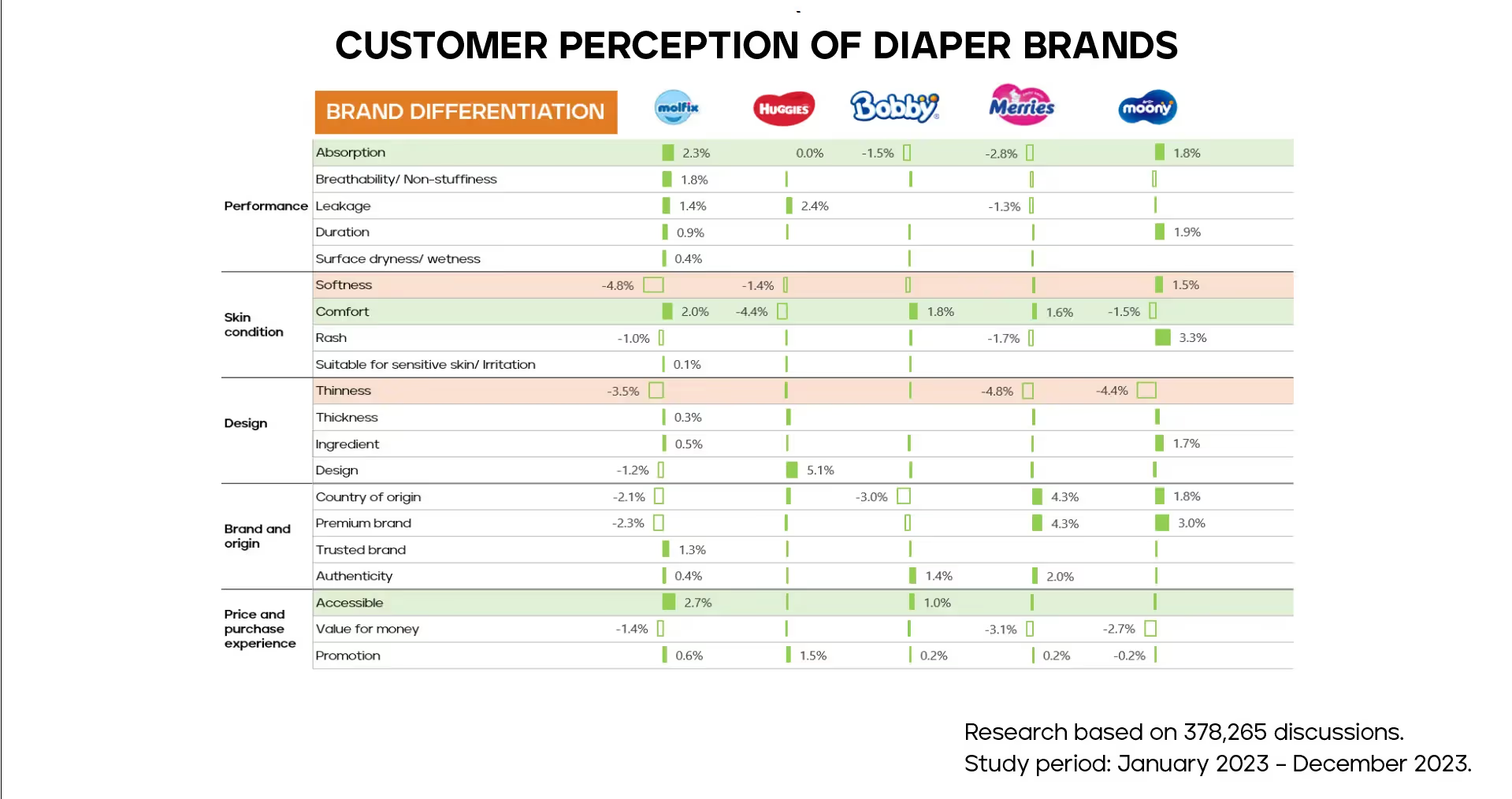
c. Usage and Attitude Research (UnA):
UnA research focuses on consumer discussions and plays a key role in unveiling the consumer landscape of an industry. It addresses key questions like:
- Users' interest levels in the product/brand on social media
- Awareness, usage, and consumer behavior displayed on social platforms
- Motivations and barriers to product/brand consumption
- General satisfaction/dissatisfaction with current products/services
- Users’ needs, unmet demands, or general expectations
d. Target Audience Segmentation:
In some cases, brands aim to understand consumers not just from a product buyer perspective but from a broader context that includes their lifestyle and habits. Social Listening can support brands in achieving this.
For instance, analyzing the most-discussed topics within Gen Alpha revealed that "love" was the top theme, surpassing even "education" and "games." This insight shows that to engage Gen Alpha, brands should consider using "love" as a central theme to attract attention and foster interaction.

→ Read more: Gen Alpha: What Sets the Next Generation of Consumers Apart?
Notably, social media is segmented by interests. Therefore, identifying user groups and their main concerns is crucial in segmenting the social media audience. Pinpointing key interests and insights will help brands align their marketing tactics with user interests. As a result, branded content and messaging are more likely to appear in users' feeds, capturing attention, generating engagement, fostering recall and affinity, or even leading to user-generated content (UGC) related to the brand.
Social Listening supports marketers in planning, creating content, and adjusting strategies in real time throughout all phases of a campaign. It helps track brand sentiment and ensures campaigns align with audience expectations.
Today, even a small complaint on Facebook can cause significant damage to a brand. As consumers become increasingly familiar with social media, the likelihood of crises occurring rises. Our Social Listening data shows that while the number of crises has decreased as brands take a more proactive role in crisis management, the average scale of a crisis has grown significantly.

Crises may seem to occur randomly and can impact any brand for seemingly arbitrary reasons. This makes social media crises difficult to track and challenging for brands to respond to. However, through Social Listening, not only can crises be monitored, but their patterns can also be identified, allowing brands to develop strategic response plans.
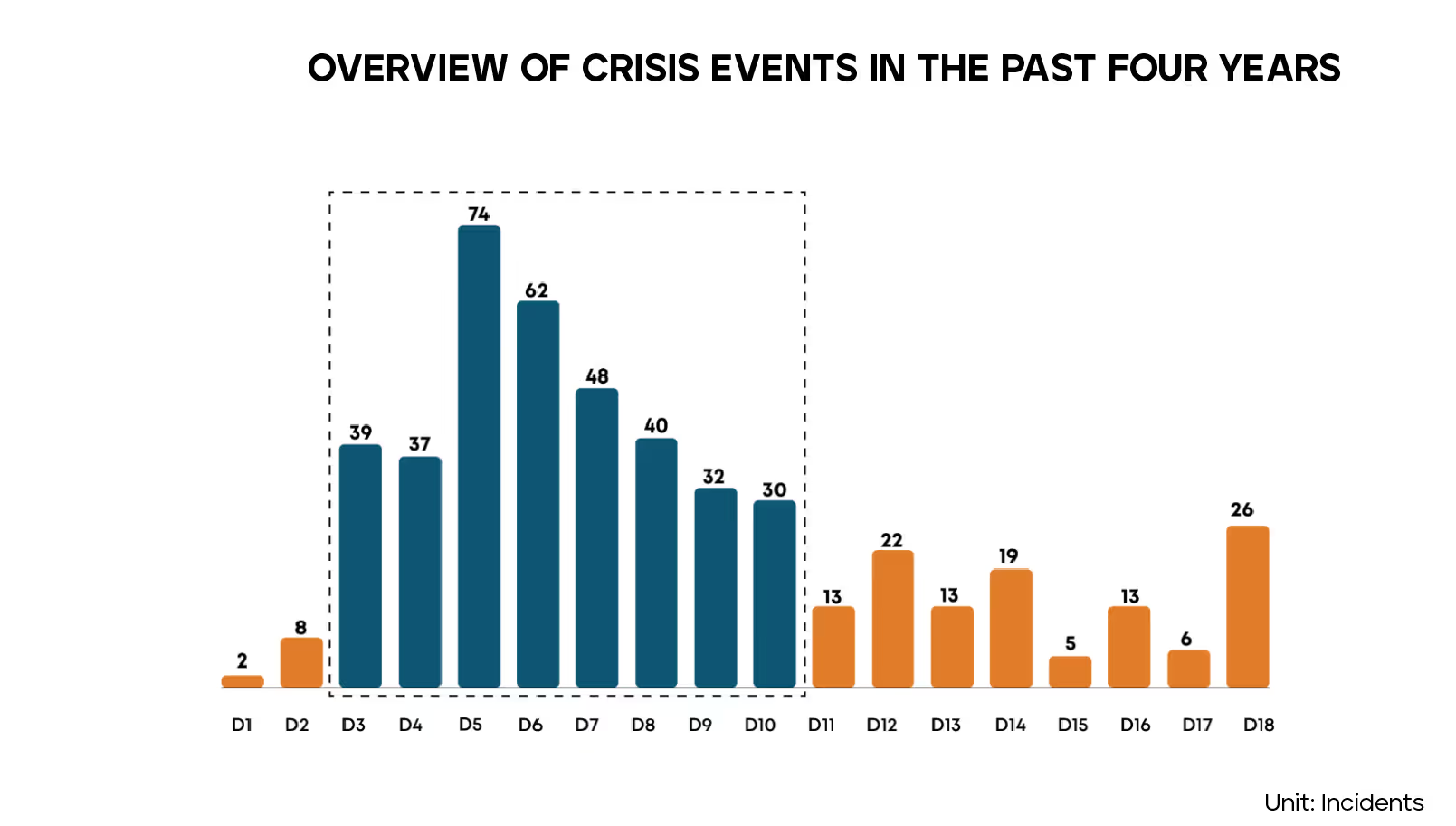
By analyzing user discussions on social media and providing actionable insights to brands, Social Listening plays a critical role in shaping communication strategies. The most common applications of Social Listening include gathering insights, tracking campaign performance, and managing crises.
To learn more about metrics, marketers can refer to here

